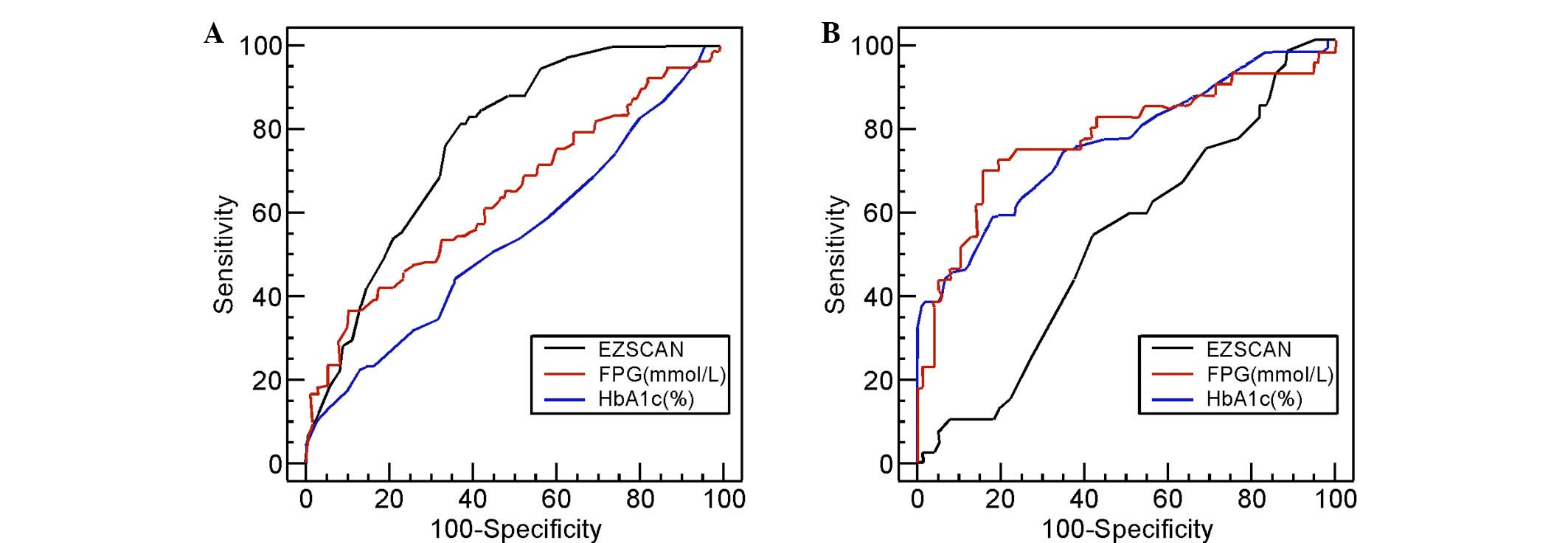|
1
|
Yang W, Lu J, Weng J, Jia W, Ji L, Xiao J,
Shan Z, Liu J, Tian H, Ji Q, et al: China National Diabetes and
Metabolic Disorders Study Group: Prevalence of diabetes among men
and women in China. N Engl J Med. 362:1090–1101. 2010. View Article : Google Scholar : PubMed/NCBI
|
|
2
|
Expert Committee on the Diagnosis and
Classification of Diabetes Mellitus. Report of the expert committee
on the diagnosis and classification of diabetes mellitus. Diabetes
Care. 26:(Suppl 1). S5–S20. 2003. View Article : Google Scholar : PubMed/NCBI
|
|
3
|
Knowler WC, Barrett-Connor E, Fowler SE,
et al: Diabetes Prevention Program Research Group: Reduction in the
incidence of type 2 diabetes with lifestyle intervention or
metformin. N Engl J Med. 346:393–403. 2002. View Article : Google Scholar : PubMed/NCBI
|
|
4
|
Chiasson JL, Josse RG, Gomis R, et al:
STOP-NIDDM Trial Research Group: Acarbose for prevention of type 2
diabetes mellitus: The STOP-NIDDM randomised trial. Lancet.
359:2072–2077. 2002. View Article : Google Scholar : PubMed/NCBI
|
|
5
|
American Diabetes Association: Standards
of medical care in diabetes - 2010 = Diabetes Care. 33:(Suppl 1).
S11–S61. 2010.
|
|
6
|
Adriaanse M, Snoek F, Dekker J, van der
Ploeg H and Heine R: Screening for Type 2 diabetes: An exploration
of subjects' perceptions regarding diagnosis and procedure. Diabet
Med. 19:406–411. 2002. View Article : Google Scholar : PubMed/NCBI
|
|
7
|
World Health Organization: Screening for
Type 2 Diabetes: Report of a World Health Organization and
International Diabetes Federation meeting. https://www.who.int/diabetes/publications/en/screeningmnc03.pdfAccessed.
March 26–2012.
|
|
8
|
Ealovega MW, Tabaei BP, Brandle M, Burke R
and Herman WH: Opportunistic screening for diabetes in routine
clinical practice. Diabetes Care. 27:9–12. 2004. View Article : Google Scholar : PubMed/NCBI
|
|
9
|
Brunswick P, Mayaudon H, Albin V, Lair V,
Ringuede A and Cassir M: Use of Ni electrodes chronoamperometry for
improved diagnostics of diabetes and cardiac diseases. Conf Proc
IEEE Eng Med Biol Soc. 2007:4544–4547. 2007.PubMed/NCBI
|
|
10
|
Mayaudon H, Miloche PO and Bauduceau B: A
new simple method for assessing sudomotor function: Relevance in
type 2 diabetes. Diabetes Metab. 36:450–454. 2010. View Article : Google Scholar : PubMed/NCBI
|
|
11
|
Ramachandran A, Moses A, Shetty S, et al:
A new non-invasive technology to screen for dysglycaemia including
diabetes. Diabetes Res Clin Pract. 88:302–306. 2010. View Article : Google Scholar : PubMed/NCBI
|
|
12
|
Hubert D, Brunswick P, Calvet JH, Dusser D
and Fajac I: Abnormal electrochemical skin conductance in cystic
fibrosis. J Cyst Fibros. 10:15–20. 2011. View Article : Google Scholar : PubMed/NCBI
|
|
13
|
Sheng CS, Zeng WF, Huang QF, Deslypere JP,
Li Y and Wang JG: Accuracy of a Novel Non Invasive technology based
EZSCAN system for the diagnosis of diabetes mellitus in Chinese.
Diabetol Metab Syndr. 3:362011. View Article : Google Scholar : PubMed/NCBI
|
|
14
|
Bao Y, Ma X, Li H, et al: Glycated
haemoglobin A1c for diagnosing diabetes in Chinese population:
Cross sectional epidemiological survey. BMJ. 340:c22492010.
View Article : Google Scholar : PubMed/NCBI
|
|
15
|
Seino Y, Nanjo K, Tajima N, et al:
Committee of the Japan Diabetes Society on the Diagnostic Criteria
of Diabetes Mellitus: Report of the committee on the classification
and diagnostic criteria of diabetes mellitus. J Diabetes Investig.
1:212–228. 2010. View Article : Google Scholar : PubMed/NCBI
|
|
16
|
Kashiwagi A, Kasuga M, Araki E, et al:
Committee on the Standardization of Diabetes Mellitus-Related
Laboratory Testing of Japan Diabetes Society: International
clinical harmonization of glycated hemoglobin in Japan: From Japan
Diabetes Society to National Glycohemoglobin Standardization
Program values. J Diabetes Investig. 3:39–40. 2012. View Article : Google Scholar : PubMed/NCBI
|
|
17
|
World Health Organization: Definition,
diagnosis and classification of diabetes mellitus and its
complications: report of a WHO consultation. Part 1: Diagnosis and
classification of diabetes mellitus. https://www.staff.ncl.ac.uk/philip.home/who_dmg.pdfAccessed.
February 26–2010.
|
|
18
|
Ozaki R, Cheung KK, Wu E, et al: A new
tool to detect kidney disease in Chinese type 2 diabetes patients:
Comparison of EZSCAN with standard screening methods. Diabetes
Technol Ther. 13:937–943. 2011. View Article : Google Scholar : PubMed/NCBI
|
|
19
|
Chen L, Chen X, Ding R, Shi Q Jr and Hu D:
Evaluation of EZSCAN as a screening tool for impaired glucose
metabolism. Diabetes Res Clin Pract. 100:210–214. 2013. View Article : Google Scholar : PubMed/NCBI
|
|
20
|
Tuomilehto J, Lindström J, Eriksson JG,
Valle TT, Hämäläinen H, Ilanne Parikka P, Keinänen Kiukaanniemi S,
Laakso M, Louheranta A, Rastas M, et al: Finnish Diabetes
Prevention Study Group: Prevention of type 2 diabetes mellitus by
changes in lifestyle among subjects with impaired glucose
tolerance. N Engl J Med. 344:1343–1350. 2001. View Article : Google Scholar : PubMed/NCBI
|
|
21
|
Hilsted J and Low PA: Diabetic autonomic
neuropathyClinical Autonomic Disorders: Evaluation and Management.
Low PA: 2nd. Lippincott-Raven; Philadelphia, PA: pp. 487–507.
1997
|
|
22
|
No authors listed. Will new diagnostic
criteria for diabetes mellitus change phenotype of patients with
diabetes? Reanalysis of European epidemiological data. DECODE Study
Group on behalf of the European Diabetes Epidemiology Study Group.
BMJ. 317:371–375. 1998. View Article : Google Scholar : PubMed/NCBI
|
|
23
|
Qiao Q, Nakagami T, Tuomilehto J, Borch
Johnsen K, Balkau B, Iwamoto Y and Tajima N: International Diabetes
Epidemiology Group; DECODA Study Group: Comparison of the fasting
and the 2 h glucose criteria for diabetes in different Asian
cohorts. Diabetologia. 43:1470–1475. 2000. View Article : Google Scholar : PubMed/NCBI
|
|
24
|
Schwarz P, Brunswick P and Calvet JH:
EZSCAN™ a new technology to detect diabetes risk. Br J Diabetes
Vasc Dis. 11:204–209. 2011. View Article : Google Scholar
|















